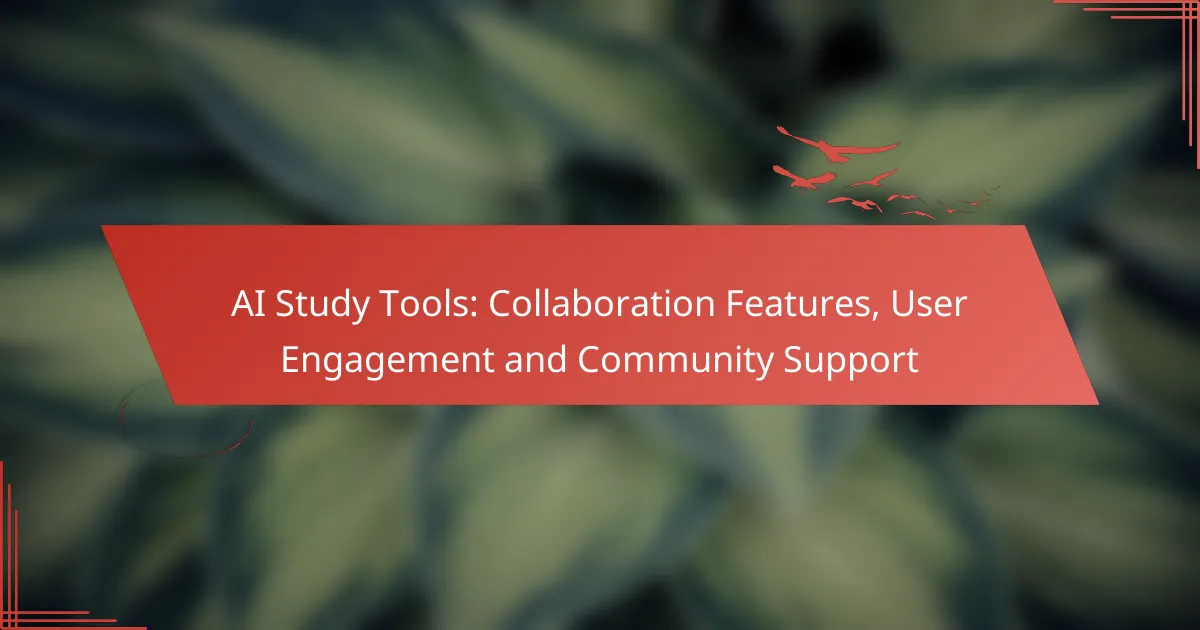AI plays a crucial role in enhancing peer interaction by improving communication, engagement, and collaboration. By utilizing advanced tools and technologies, AI streamlines interactions, making them more efficient and effective, which ultimately fosters a more participatory environment. These innovations not only facilitate clearer communication but also automate tasks, ensuring that teams remain engaged and informed throughout their projects.
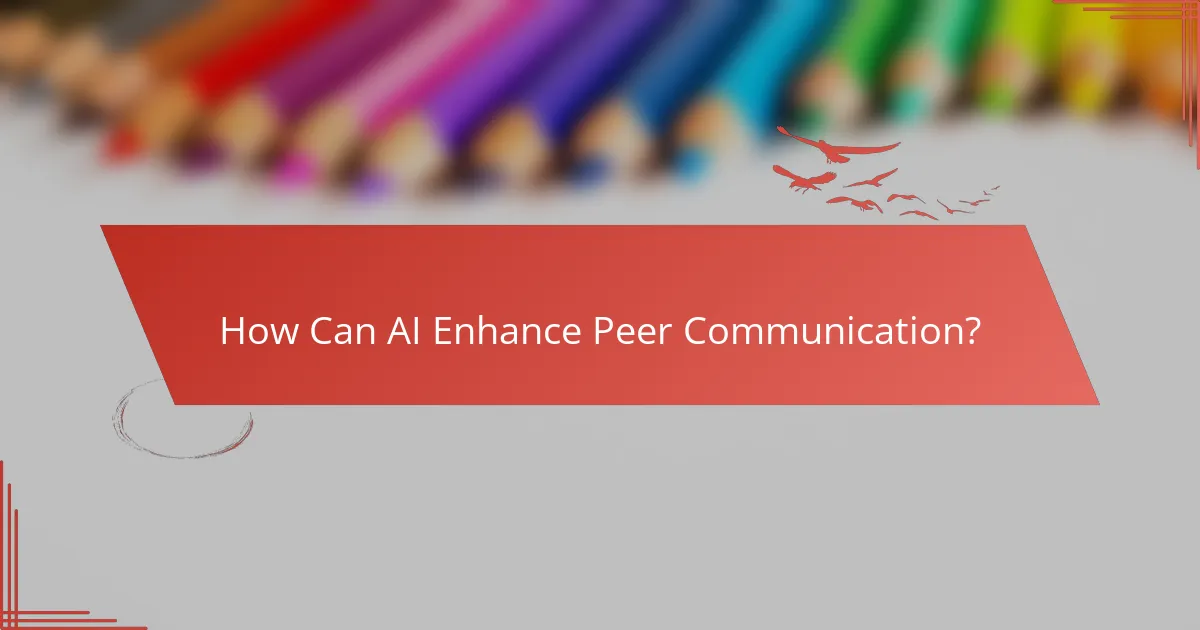
How Can AI Enhance Peer Communication?
AI can significantly improve peer communication by facilitating clearer interactions, fostering engagement, and enabling collaboration. Through various tools and technologies, AI streamlines communication processes, making them more efficient and effective.
Real-time language translation
Real-time language translation allows peers who speak different languages to communicate seamlessly. AI-powered translation tools can convert spoken or written language instantly, reducing misunderstandings and enhancing collaboration across diverse teams.
For example, platforms like Google Translate and Microsoft Translator offer real-time translation features that can be integrated into messaging apps or video conferencing tools. This capability is particularly valuable in multinational organizations where team members may be located in different countries.
Sentiment analysis for feedback
Sentiment analysis uses AI to evaluate the emotional tone behind written or spoken communication. This technology helps teams gauge reactions to ideas, proposals, or feedback, allowing for more nuanced discussions and adjustments based on peer sentiment.
By analyzing text from emails or chat messages, tools can provide insights into how team members feel about specific topics. This can guide leaders in addressing concerns or reinforcing positive feedback, ultimately fostering a more supportive environment.
Automated meeting summaries
Automated meeting summaries generated by AI can save time and ensure that key points are captured accurately. These tools transcribe discussions and highlight action items, making it easier for team members to stay aligned on goals and responsibilities.
Using services like Otter.ai or Microsoft Teams, organizations can automatically generate summaries that can be shared with all participants. This feature helps reduce the burden of note-taking and allows peers to focus on the conversation itself.
Personalized communication suggestions
AI can provide personalized communication suggestions based on individual preferences and past interactions. By analyzing communication styles and content, AI tools can recommend the best ways to engage with specific peers, enhancing clarity and effectiveness.
For instance, tools like Grammarly offer suggestions on tone and style, helping users tailor their messages to different audiences. This personalization can lead to more meaningful interactions and improved collaboration among team members.
Chatbots for instant responses
Chatbots powered by AI can deliver instant responses to common queries, improving peer communication efficiency. These bots can handle routine questions, freeing up team members to focus on more complex issues that require human intervention.
Implementing chatbots in platforms like Slack or Microsoft Teams can streamline communication by providing quick answers or directing users to relevant resources. This capability is especially beneficial in large organizations where information overload can hinder productivity.
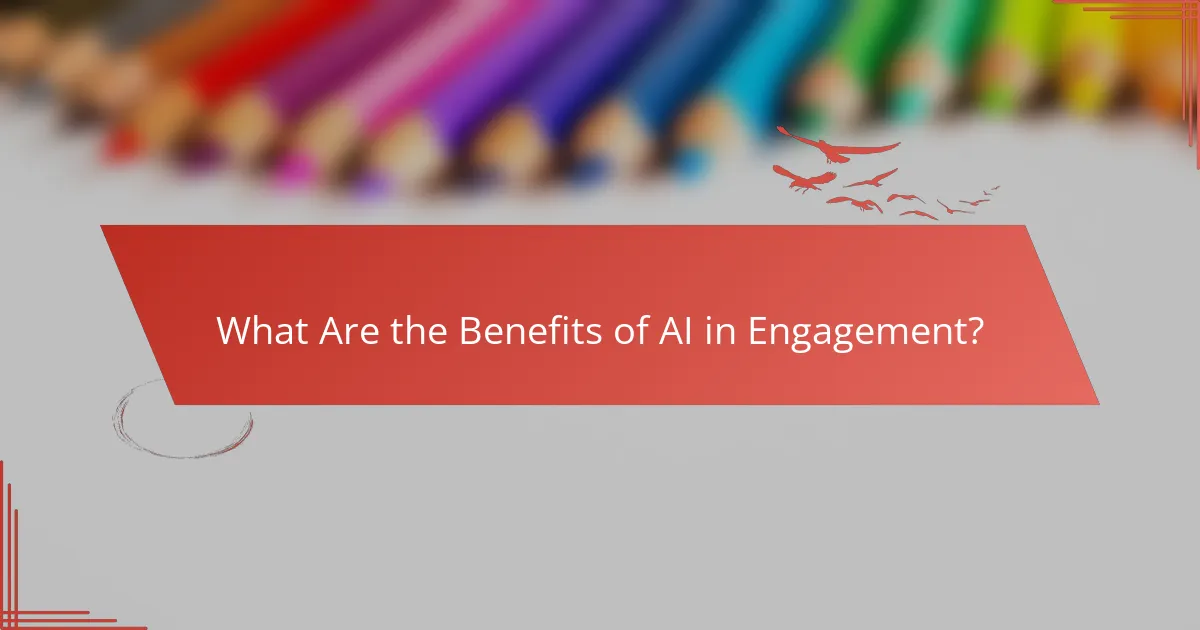
What Are the Benefits of AI in Engagement?
AI enhances engagement by facilitating better communication and collaboration among peers. It streamlines interactions, making them more efficient and effective, ultimately leading to higher participation and satisfaction.
Increased participation rates
AI tools can significantly boost participation rates by automating reminders and personalizing communication. For instance, chatbots can engage users with tailored messages, prompting them to join discussions or events.
Additionally, AI can analyze user behavior to identify optimal times for engagement, ensuring that messages reach users when they are most likely to respond. This targeted approach can lead to participation increases of 20-30% in various settings.
Improved user experience
AI enhances user experience by providing instant support and personalized content. For example, virtual assistants can answer questions in real-time, reducing wait times and frustration.
Moreover, AI can curate content based on individual preferences, making interactions more relevant and enjoyable. This level of customization fosters a sense of belonging and encourages users to engage more actively.
Data-driven insights on engagement
AI generates valuable data-driven insights that help organizations understand engagement patterns. By analyzing user interactions, AI can reveal trends and preferences, guiding future strategies.
For example, organizations can track which topics generate the most interest or identify peak engagement times. This information allows for informed decision-making, optimizing efforts to enhance overall engagement.

Which AI Tools Facilitate Collaboration?
Several AI tools enhance collaboration by streamlining communication and automating tasks. These tools help teams work more efficiently, ensuring that everyone stays engaged and informed throughout projects.
Slack with AI integrations
Slack offers various AI integrations that improve team communication and project management. Features like automated reminders, smart replies, and sentiment analysis help users stay on top of conversations and tasks.
For example, AI can analyze message trends to suggest optimal times for meetings or identify topics that require urgent attention. Teams can leverage these insights to enhance their collaboration efforts.
Trello with automation features
Trello incorporates automation features through its Butler tool, which allows users to create custom workflows. This can include automating repetitive tasks, such as moving cards between lists based on specific triggers.
By using automation, teams can save time and reduce errors, ensuring that everyone is aligned on project progress. For instance, automatically assigning tasks to team members when a card is moved can streamline accountability.
Microsoft Teams with AI capabilities
Microsoft Teams integrates AI capabilities to enhance collaboration through features like real-time transcription and translation. These tools facilitate communication among team members who speak different languages or need accessibility support.
Additionally, AI-driven insights can help identify engagement levels during meetings, allowing teams to adjust their strategies for better participation. Utilizing these features can significantly improve overall team dynamics and productivity.
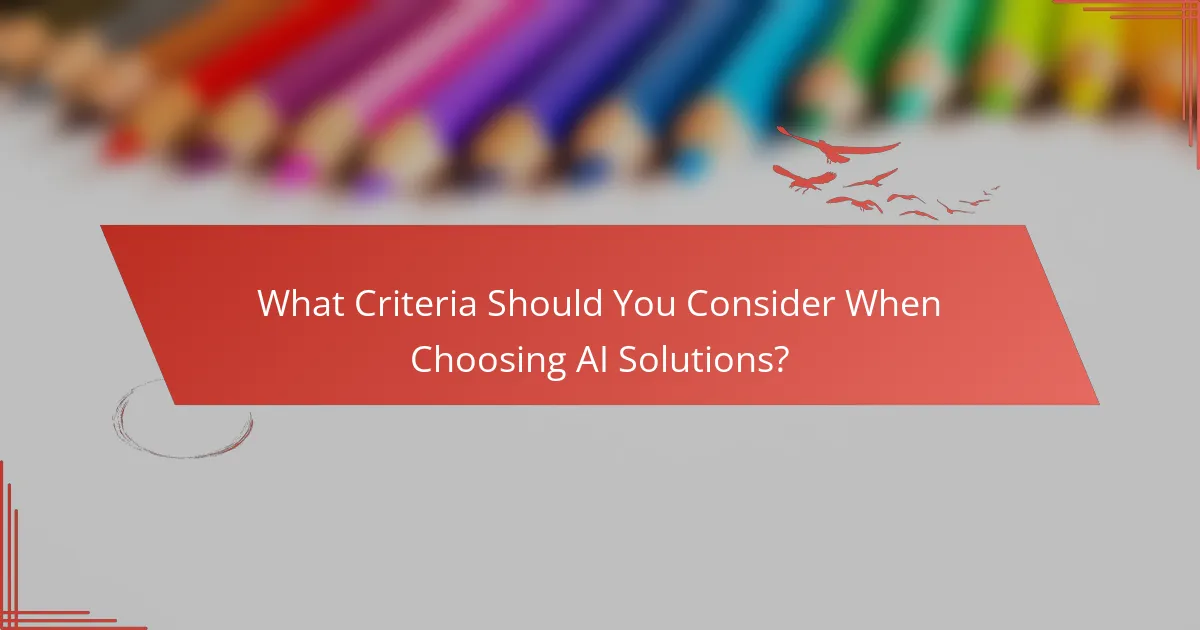
What Criteria Should You Consider When Choosing AI Solutions?
When selecting AI solutions for peer interaction, focus on integration, user-friendliness, and scalability. These criteria ensure that the technology enhances communication and collaboration without disrupting existing workflows.
Integration with existing tools
Choose AI solutions that seamlessly integrate with your current tools and platforms. This compatibility minimizes disruption and allows for a smoother transition, ensuring that users can adopt the new technology with ease.
Consider solutions that offer APIs or plugins for popular software like Slack, Microsoft Teams, or Google Workspace. This can enhance functionality without requiring extensive retraining or changes to established processes.
User-friendliness
User-friendliness is crucial for encouraging adoption among team members. An intuitive interface and straightforward navigation can significantly reduce the learning curve and increase engagement.
Look for AI tools that provide clear onboarding resources, such as tutorials or help centers. Solutions that allow customization based on user preferences can also enhance the overall experience.
Scalability for future needs
Scalability is essential for accommodating growth and evolving requirements. Choose AI solutions that can expand in functionality and user capacity as your organization grows.
Evaluate whether the solution can handle increased data loads or additional users without performance degradation. It’s beneficial to select platforms that offer tiered pricing or features that can be unlocked as needed, ensuring long-term value.
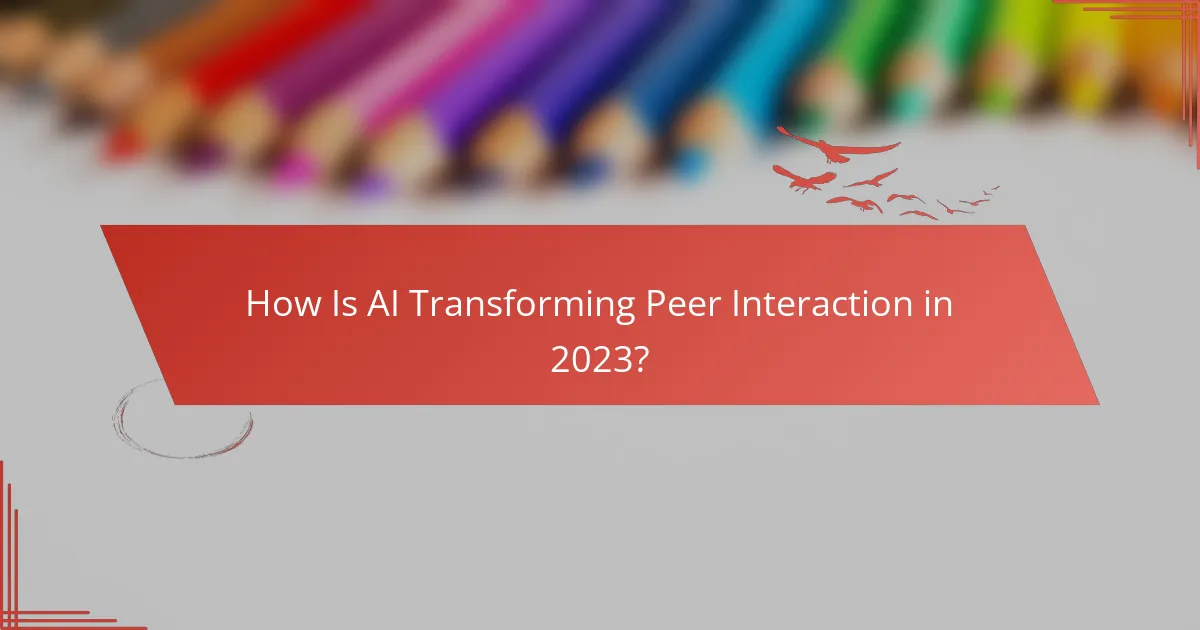
How Is AI Transforming Peer Interaction in 2023?
AI is significantly enhancing peer interaction in 2023 by facilitating seamless communication, improving engagement, and fostering collaboration among team members. These advancements are particularly evident in remote work environments, where AI tools streamline processes and support interpersonal connections.
Increased remote collaboration
AI technologies are revolutionizing remote collaboration by providing tools that enhance communication and project management. For instance, platforms like Slack and Microsoft Teams utilize AI to prioritize messages and suggest relevant documents, making it easier for teams to stay aligned.
Additionally, AI-driven virtual assistants can schedule meetings, manage tasks, and even analyze team performance, ensuring that everyone remains productive and engaged. This level of support helps to bridge the gap created by physical distance, allowing for more effective teamwork.
Enhanced data security measures
With the rise of remote collaboration, AI is also playing a crucial role in enhancing data security. AI systems can detect unusual patterns in user behavior, flagging potential security breaches before they escalate. This proactive approach helps organizations safeguard sensitive information and maintain compliance with regulations.
Moreover, AI can automate encryption processes and manage access controls, ensuring that only authorized personnel can access critical data. This layered security approach is vital for businesses operating in sectors with strict data protection requirements.
Focus on mental health support
AI is increasingly being utilized to support mental health in workplace settings. Tools like chatbots and virtual counseling services provide employees with immediate access to mental health resources, helping to reduce stigma and encourage open conversations about well-being.
Furthermore, AI can analyze employee sentiment through communication patterns, allowing organizations to identify potential issues and address them proactively. By prioritizing mental health, companies can foster a more supportive work environment, ultimately enhancing overall productivity and employee satisfaction.
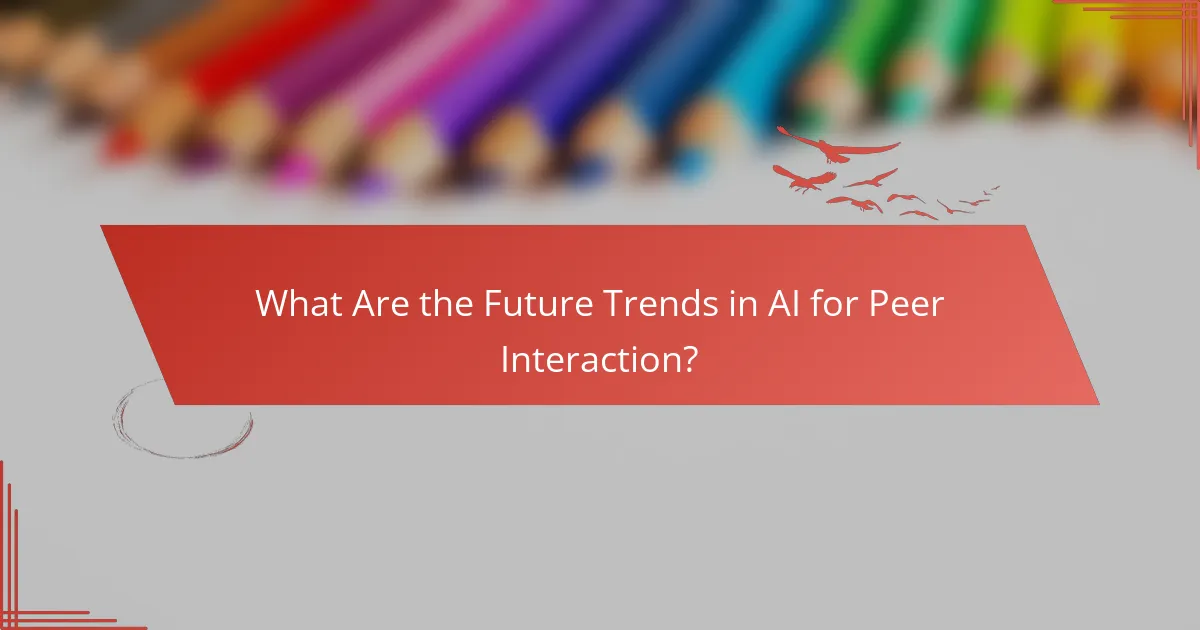
What Are the Future Trends in AI for Peer Interaction?
Future trends in AI for peer interaction focus on enhancing communication, engagement, and collaboration through advanced technologies. These developments aim to create more intuitive and responsive platforms that facilitate seamless interactions among peers.
Increased Personalization
AI is set to drive increased personalization in peer interactions by analyzing user behavior and preferences. This allows platforms to tailor content, notifications, and communication styles to individual users, enhancing engagement and satisfaction.
For example, AI algorithms can suggest relevant topics or connections based on a user’s past interactions, making it easier to find common ground with peers. As a result, users may experience a more meaningful and engaging interaction environment.
Enhanced Collaboration Tools
Future AI developments will likely introduce enhanced collaboration tools that streamline teamwork. These tools will incorporate features like real-time language translation, smart scheduling, and automated task management, making it easier for teams to work together across different time zones and languages.
For instance, platforms may utilize AI to automatically assign tasks based on team members’ strengths and availability, improving overall productivity. This can significantly reduce the time spent on coordination and increase focus on project outcomes.
Improved Emotional Intelligence
AI is advancing in its ability to recognize and respond to emotional cues, which can greatly benefit peer interactions. By analyzing tone, sentiment, and body language, AI systems can provide feedback or suggestions to improve communication dynamics.
For example, an AI-driven tool could alert users when a conversation is becoming tense, suggesting a change in approach or offering calming strategies. This capability can foster a more supportive and understanding environment among peers.
Data-Driven Insights
As AI continues to evolve, it will offer data-driven insights that help organizations understand peer interactions better. By analyzing communication patterns and engagement metrics, businesses can identify areas for improvement and optimize their collaboration strategies.
For instance, organizations might track participation rates in discussions or the effectiveness of various communication channels, allowing them to make informed decisions about resource allocation and training needs.


